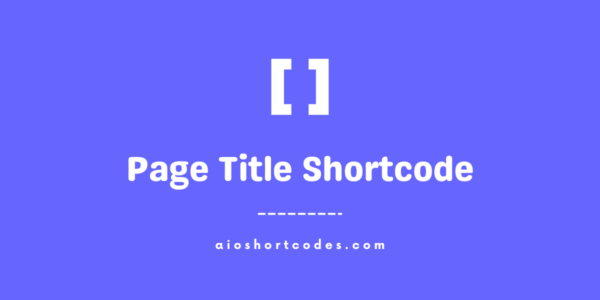https://aioshortcodes.com/docs/page-url-shortcode/
[aio_page_url]
In this tutorial, we’ll walk you through the usage of the WordPress Page URL Shortcode, exploring various options for customizing its functionality.
Let’s delve into simplifying page URL-related content creation with the AIO Shortcodes plugin!
Getting Started With Page URL Shortcode
To use the [aio_page_url] shortcode, make sure you have the AIO Shortcodes plugin installed and activated on your WordPress website.
This shortcode can be used anywhere inside your WordPress content, including post/page content, headings, lists, paragraphs, sidebars, widgets, menu items, etc.
Basic Usage Of [aio_page_url]
Once the AIO Shortcodes plugin is installed and activated, generating the page URL using the WordPress shortcode [aio_page_url] is straightforward.
- Input: [aio_page_url]
- Output: https://aioshortcodes.com/docs/page-url-shortcode/ – (page URL with default values)
Let’s explore its full potential through common examples and enhance your user experience.
Advanced Options And Attributes
The shortcode comes with advanced options to further customize its functionality.
Using the ‘id’ Attribute:
The ‘id‘ attribute allows you to specify the page ID and generate the URL accordingly.
Basic format: [aio_page_url id="x"], where ‘x’ is the page’s special ID.
- Input: [aio_page_url id="123"]
- Output: https://aioshortcodes.com/docs/post-url-shortcode/ – (page URL associated with the ID 123)
To find the page ID, navigate to your WordPress dashboard, edit the page, and identify the “post=(ID-NUMBER)” section in the URL inside the address bar.
Using the ‘link’ Attribute:
The ‘link‘ attribute in the shortcode [aio_page_url link="yes/no"] determines whether the page URL should be linked. The default value is ‘yes‘.
Basic format: [aio_page_url link="yes/no"]
- Input: [aio_page_url link="no"]
- Output: https://aioshortcodes.com/docs/page-url-shortcode/ – (plain page URL without a link)
- Input: [aio_page_url link="yes"]
- Output: https://aioshortcodes.com/docs/page-url-shortcode/ – (default link type: plain page URL with a link)
Using the ‘new_window’ Attribute:
The ‘new_window‘ attribute in the page URL shortcode specifies whether the link if created, should open in a new window. The default value is ‘no‘.
Basic format: [aio_page_url new_window="yes/no"]
- Input: [aio_page_url new_window="yes"]
- Output: https://aioshortcodes.com/docs/page-url-shortcode/ – (page URL with a link that opens in a new window)
Using the ‘class’ Attribute:
The ‘class‘ attribute in the shortcode [aio_page_url class="custom-class"] specifies the CSS class for the link.
Basic format: [aio_page_url class="custom-class"]
- Input: [aio_page_url class="custom-class"]
- Output: https://aioshortcodes.com/docs/page-url-shortcode/ – (page URL with a custom CSS class to add your own styling)
Combined Attributes:
Combine attributes for a more tailored page URL.
- Input: [aio_page_url id="123" link="no" class="custom-class" new_window="yes"]
- Output: https://aioshortcodes.com/docs/post-url-shortcode/ – (customized page URL with specified attributes)
Shortcode Combinations & Output Samples
Here’s a table of different examples using the [aio_page_url] shortcode with various attributes:
| Input | Output | Description |
|---|---|---|
| [aio_page_url] | https://aioshortcodes.com/docs/page-url-shortcode/ | Output the page URL with default values |
| [aio_page_url id="123"] | Output with plain post URL without a link | Output with the page URL with a specified ID |
| [aio_page_url link="no"] | https://aioshortcodes.com/docs/page-url-shortcode/ | Output with plain page URL without a link |
| [aio_page_url class="custom-class"] | https://aioshortcodes.com/docs/page-url-shortcode/ | Output page URL with a custom CSS class |
| [aio_page_url new_window="yes"] | https://aioshortcodes.com/docs/page-url-shortcode/ | Output page URL with a link that opens in a new window |
| [aio_page_url id="123" link="no"] | https://aioshortcodes.com/docs/post-url-shortcode/ | Output page URL with a specified ID and no link |
| [aio_page_url id="123" class="custom-class"] | https://aioshortcodes.com/docs/post-url-shortcode/ | Output page URL with a specified ID and custom CSS class |
| [aio_page_url id="123" link="yes" class="custom-class" new_window="yes"] | https://aioshortcodes.com/docs/post-url-shortcode/ | Output page URL with the specified ID, a custom CSS class, and a link that opens in a new window |
Feel free to use any combination of these attributes to customize the appearance and behaviour of page URLs using AIO Shortcodes on your WordPress website.
Still not using AIO Shortcodes?
Install our plugin to boost your site’s content SEO, automate your affiliate marketing, and lots more, just by using these simple WordPress shortcodes.







